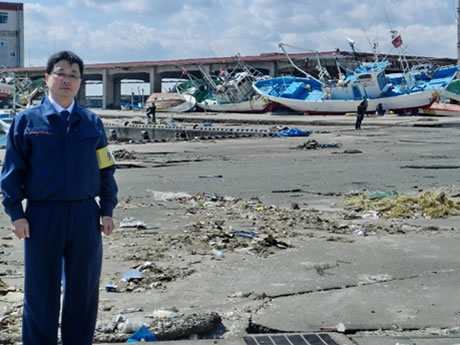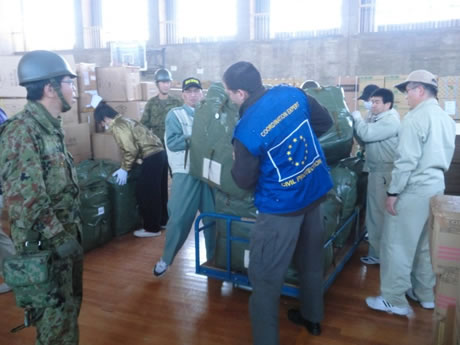Great East Japan Earthquake :
Working as a Liaison Officer for the EU Emergency Aid Team
![]()
Almost all European countries* offered assistance in the wake of the earthquake on March 11. Japan eventually received rescue teams from five countries and relief supplies from 19 countries, and funds from many other countries of Europe. Rescue and aid teams from different countries and regions were often accompanied by liaison officers from the Ministry of Foreign Affairs (MOFA) of Japan when they went to the disaster-hit area. They were needed as they are familiar with the countries where the teams came from, to help the teams and the Japanese side share information and communicate with each other better and to solve problems that may have arisen in the field, in a flexible manner.
As one of such officials, I accompanied the civil protection team from the European Union (EU). Between March and April, this team delivered relief supplies from nine EU member countries out of the 19 European countries that provided assistance. They delivered bedding and radiation meters to Ibaraki, Tochigi, and Miyagi prefectures, and also taught people how to use these meters. I worked hard to address the difficult task of reconciling the stance of the donors with that of the recipients. The donors told me that upon being informed of the needs in the disaster-hit area, they would refer to the member countries and report how much they could deliver. The recipients, on the other hand, said that upon being informed of what the donors can deliver, they would refer to the affected areas and tell how much they need. The relief items were delivered as soon as they became available after this coordination process. The situation was so critical that it was impossible to wait for all the supplies to arrive from the EU side. The team thus repeated the task of receiving just-arrived items at Narita airport and delivering them to the afflicted areas. The team members had to travel every day: for instance, they made a one-day round trip between Narita and the outskirts of Sendai; and the next day, they delivered radiation meters to Ibaraki Prefecture and taught people how to use them there.
Many of the members of civil protection team from the EU were fire fighters or rescue squad members by profession. One day, after the team delivered supplies to the gymnasium of a fire academy in Tochigi Prefecture, they toured the Disaster Preparedness Learning Center at the site and saw the facilities that give simulations for visitors to experience an earthquake, heavy rain, gale and smoke, as well as the exhibits of disaster response kits. The team members, in learning from Japan, were able to reflect on their individual circumstances. One member told me that he was surprised at the high level of Japan’s disaster preparedness education for the public and would report this back home. At the same time, he has realized how devastating the March 11 disaster was, commenting “Even with such a high level of disaster preparedness, Japan could not withstand the tsunami.”
Looking ahead, I hope that Japan and the EU will further strengthen bilateral ties in the area of disaster preparedness and disaster response as well.
Kazuo Chujo
Counsellor, the Mission of Japan to the European Union
(Mr. Chujo accompanied the EU emergency aid team as a MOFA liaison officer.)

Mr. Chujo, at the time accompanying European Commission members and emergency aid team from EU, in Kitaibaraki City, Ibaraki Prefecture

Team members unloading relief supplies with Japan’s Self-Defense Forces personnel in Yamamoto Town, Miyagi Prefecture.
* “European countries” here refers to the counties covered by Section 4, Chapter 2: EU member states (Austria, Belgium, Bulgaria, Cyprus, Czech Republic, Denmark, Estonia, Finland, France, Germany, Greece, Hungary, Ireland, Italy, Latvia, Lithuania, Luxembourg, Malta, the Netherlands, Poland, Portugal, Romania, Slovakia, Slovenia, Spain, Sweden, and the United Kingdom) and Albania, Andorra, Azerbaijan, Belarus, Bosnia and Herzegovina, Croatia, Georgia, Kosovo, Macedonia, Moldova, Monaco, Norway, Serbia and Montenegro, and Ukraine.

